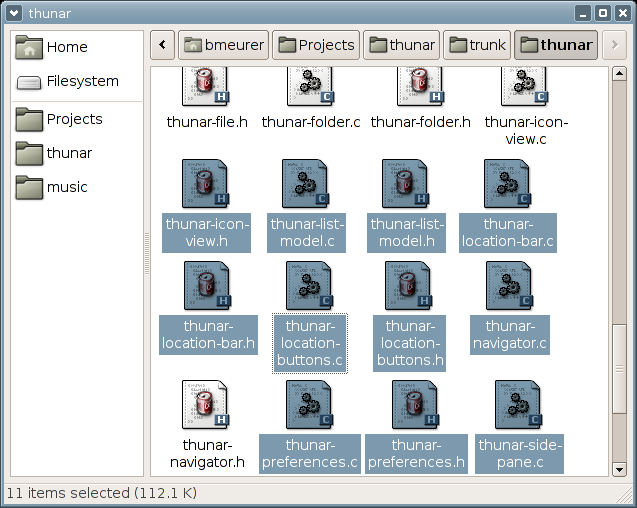I have a more or less working prototype for the ThunarFavourites module now (well, it currently works a little bit different from the shortcuts list in GtkFileChooser, but I’m not going to care for that now). You can add favourites using DnD from every DragSource that supports text/uri-list (e.g. from the location buttons or another file manager such as Nautilus), or reorder favourites internally. There’s no way to remove favourites currently (except editing ~/.gtk-bookmarks manually of course), but that’s not important for now. All the low-level stuff in ThunarFavouritesModel is connected properly now. So the next step is to add some more stuff to the ThunarIconView GUI, and then I’ll be ready to continue work on the low-level stuff, esp. the VFS Monitor and the trash system (unfortunately nobody volunteered to help with the trash system).
Note that this doesn’t mean, that the prototype can do anything useful now; it’s just in a state where it can be used to test the underlying modules from the GUI, not only from automated test suites.
On the usability front, Erik and David seem to be serious about the usability team which will be a real win for Thunar - and probably for Xfce as well, tho it was a bit problematic in the past with usability suggestions, the last failed attempt from Eugenia comes to mind here. ;-)
os-cillation is looking for a Perl guru to take part in a bigger project. So, in case you are looking for an interesting job and live in Siegen, Germany (or near to Siegen), send a mail to info@os-cillation.com.
Benjamin Muskalla came up with another website mockup today. It’s clean and simple (the side pane is a bit busy probably, but that could be optimized). The mockup is available here.
Enlightenment’s Carsten Haitzler (the rasterman) came up with a benchmark about 2 weeks ago, that was meant to measure the performance of today’s most popular window managers for X11. Surprise, suprise, E17 is on top of both lists.
His benchmark tool measures both the throughput of a window manager (mapping windows and testing the time taken by the window manager) and the response time (measuring the time between the XMapWindow request and the map to be done). The benchmark itself is well done and ok. Unfortunately, the result tells nothing about the daily use of a window manager, tho.
But it’s good to know that there’s E17, just in case I’ll ever need a window manager that can handle 260 window mapping requests per second.
The article itself is definitely a good marketing joke to make people aware of E17, but not a serious benchmark for common use-cases of a window manager. And indeed, it works pretty well: E17 will gain a lot of new clueless users thanks to this article (maybe even some smart users, who just came to know E17 by this article).
People tend to prefer pictures, so screenshot first:

On the informative side, I redefined the basic UI interfaces, and now all navigational UI elements in a ThunarWindow will implement the ThunarNavigator interface. In addition, there are separate interfaces for elements that can be placed in the side pane and for elements that provide a location bar. This makes support for plugins in this area very easy. The main view does not implement ThunarNavigator currently, because it needs special treatment to get proper error handling (e.g. if a user tries to enter a directory, which he’s not allowed to enter, the window should display an error message and fallback to another directory, and this must be performed by exactly one module, the ThunarWindow, and so the ThunarWindow must perform the initial opendir on the folder). In addition, there must be async error support for the main view to properly support error handling with the ThunarVfsMonitor module.
